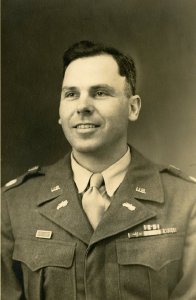Frank Spiess Sr. enlisted in the Louisiana National Guard in the 1920s and was commissioned an officer in 1930. He served with distinction and rose through the ranks in the 156th Infantry Regiment and the 141st Field Artillery Regiment in New Orleans.
As World War II approached and the military began to mechanize, a new anti-tank unit was formed from the 141st, command by Captain (later Lt. Col.) Frank Spiess. The unit first appeared as the 773rd Tank Destroyer Battalion (Provisisional), and participated in the Louisiana Maneuvers in 1941. After this, the unit was re-designated as the 773rd Tank Destroyer Battalion, and began training at bases across the United States. The basic unit trainning was done in California, wih more training done in Indiana and Tennessee. After basic unit training and maneuvers in the United States, the 773rd Tank Destroyer Battalin shipped to England, and landed in Europe shortly after the D-Day landings of June 6,1944. The 773rd Tank Destroyer Battalion served in the European Therater of Operations, largely with the 90th Infantry Division. The unit gained a reputaion for success as it moved from France to Germany and Czechoslovakia. Campaign Streamers awarded to the unit include: Northern France, Ardenne-Alsace, Rhineland, and Central Europe.
Further recognition was given for the unit's activities in the Argentan-Falaise Pocket and at the Moselle and Sarre Rivers. As the Nazi regime collapsed and the Allied troops pushed through Germany, "A" Company was tasked with guarding a sald mine at Merker, which the enemy was using to store 400 billion dollars worth of currency, 100 tons of gold bullion, and valuable stolen art and cultural treasures. The battalion was with the first Allied force to enter Czechoslovakia just before the war ended.
Colonel Spiess returned to the Louisiana National Guard after the war ended, helping Major General Raymond Fleming re-organize it. He served as Assistant Adjutant General to Fleming and MG Raymond Hufft before serving with the NAtional Guard Bureau in Washington D.C. After Retirement, Colonel Spiess was very active in veterans associations conneced to both federal and state service. Louisiana National Guard Documentation and pictures from the post-war show the immese influence and presence Colonel Spiess had on the organization. Spiess is connected to the two most histroic ubits if the LANG (the 141st FA BN and the 156th IN RGT) as well as being the first commander of one of its more significant wartime units (the 773rd TD BN). A large percentage of official Guard documentation from the 1940s, 1950, and 1960s bears Spiess' signiture block and it is clear that he was a vital member of the command staff under two of the LANG's most influential adjutant generals. Honored as one of the few inductees of the Louisiana National Guard Hall of Fame, Colonel Frank Spiess stands out as a major figure in state military history.
The two collections used for this exhibit were generously donated by Col. Spiess' son, Frank Spiess Jr., and his grandson, Frank Spiess III.
Visit the LANG flickr page to view Lt. Col. Spiess' personal wartime album at: https://www.flickr.com/photos/135494236@N06/albums/72157660527094141

